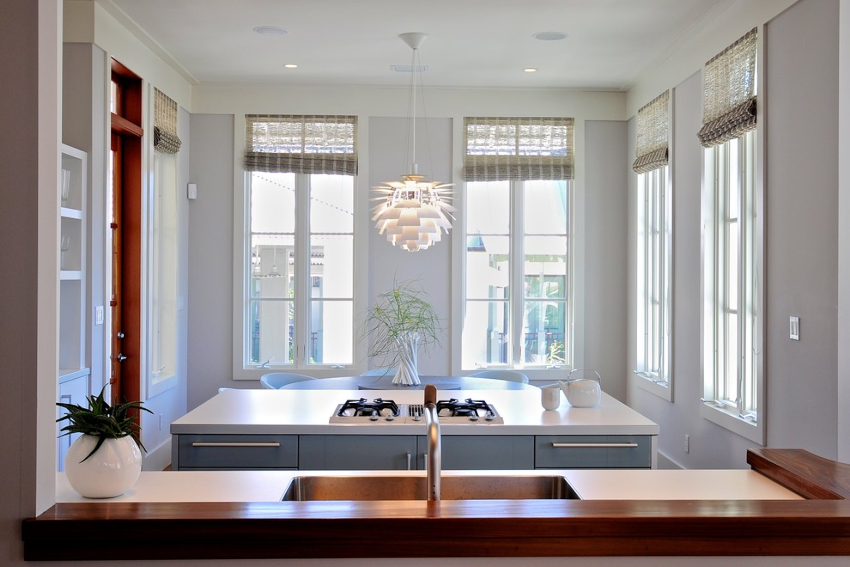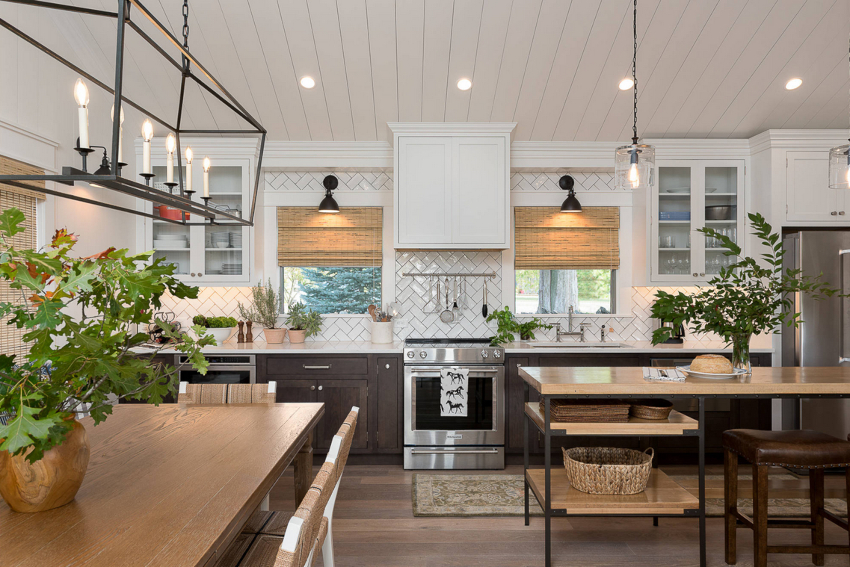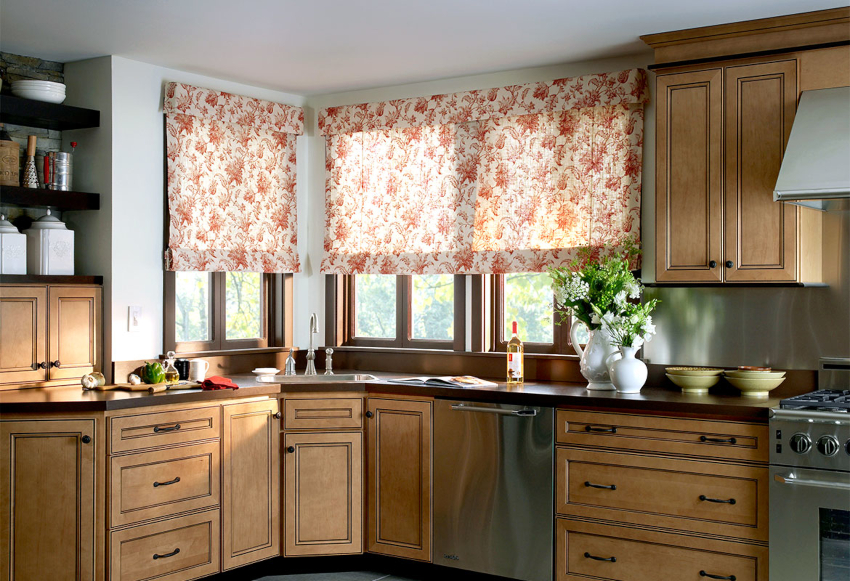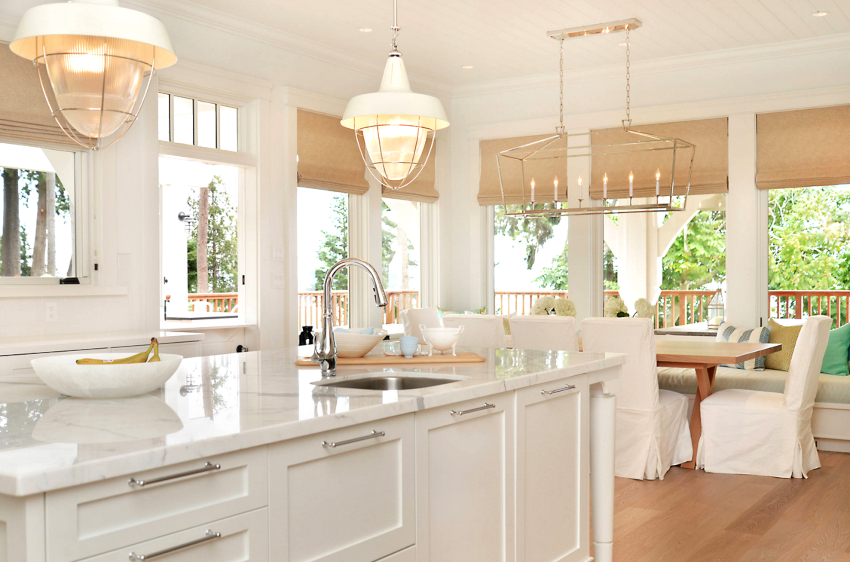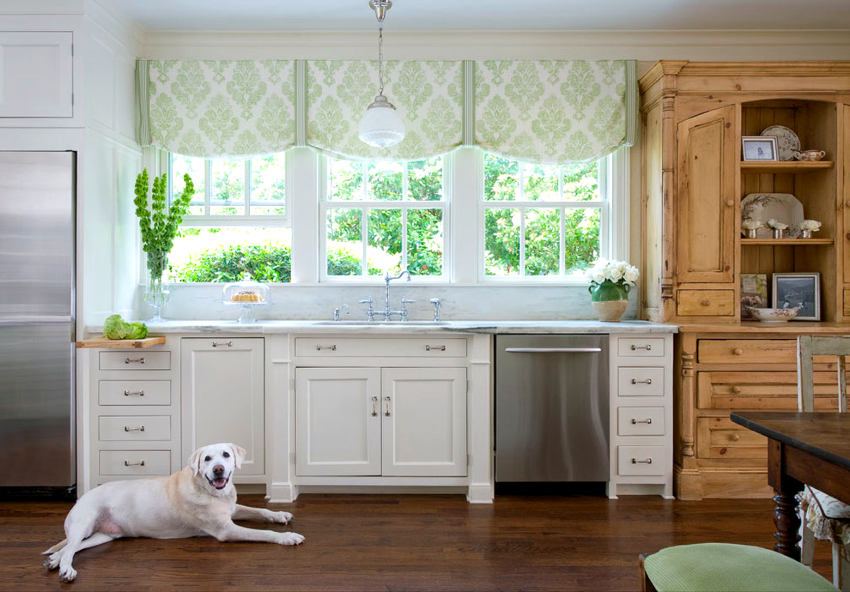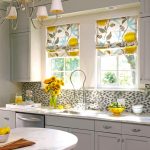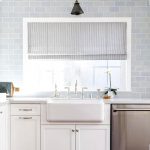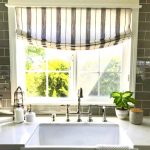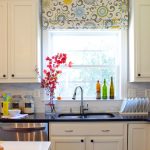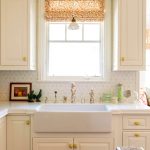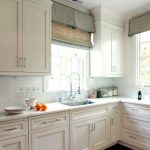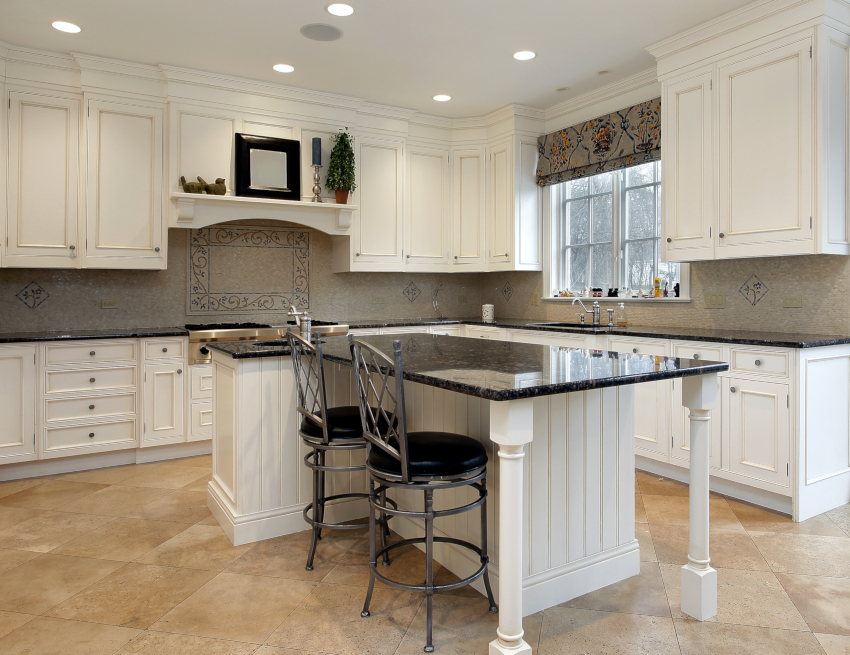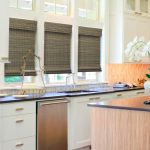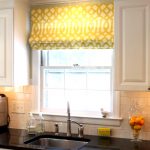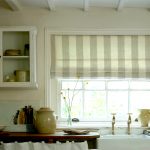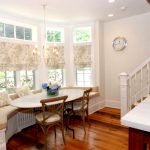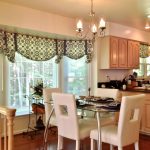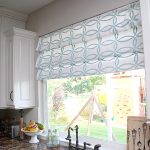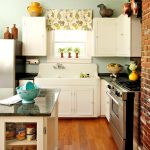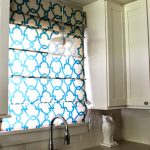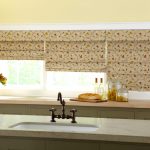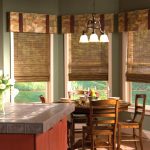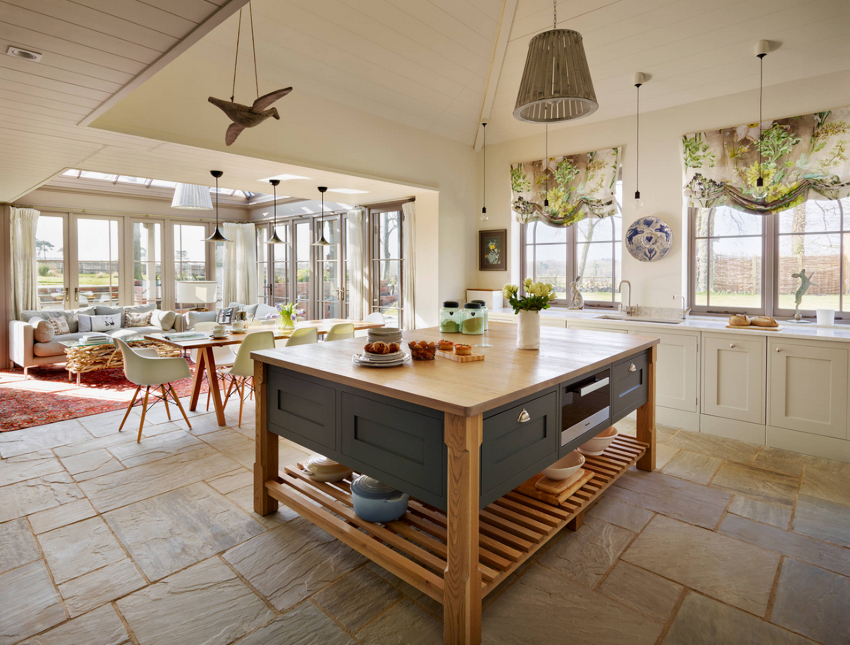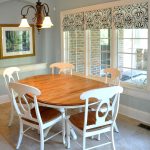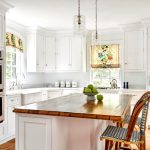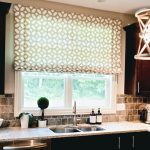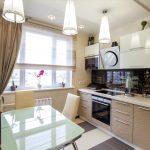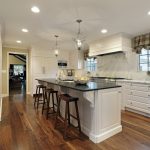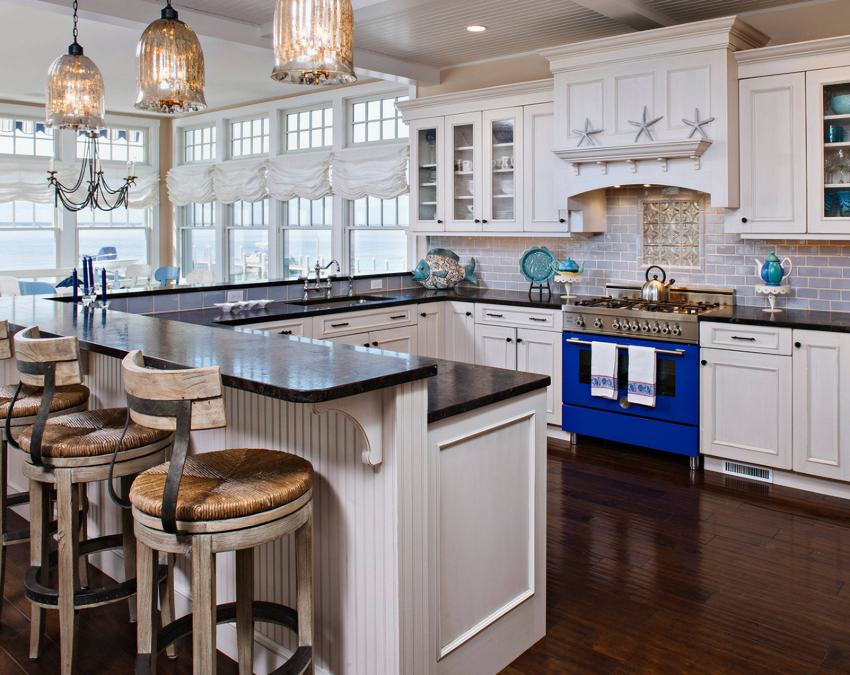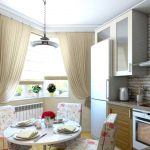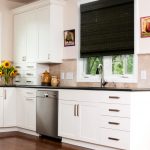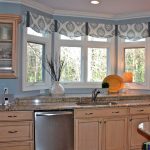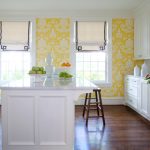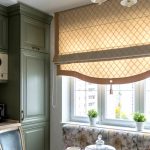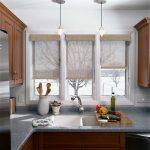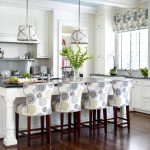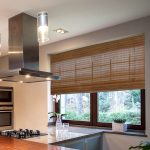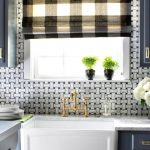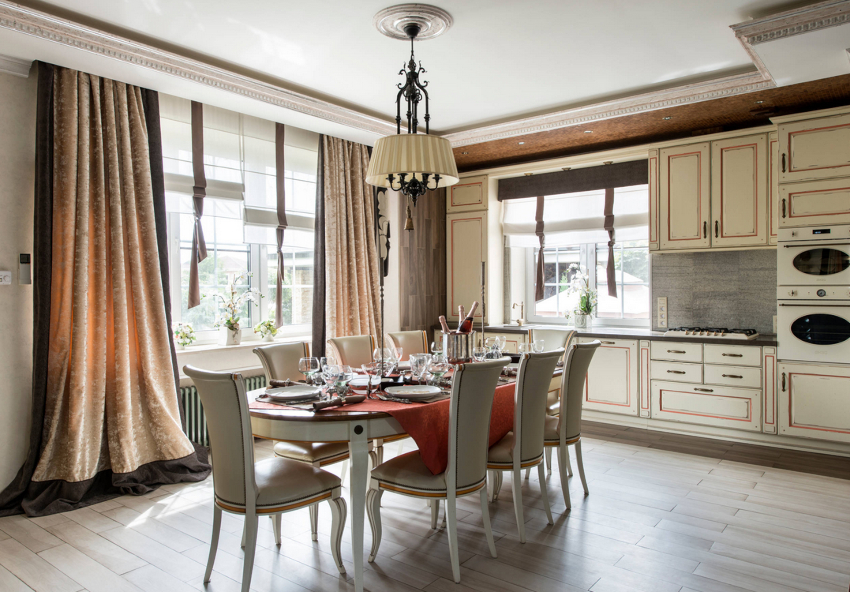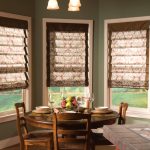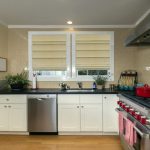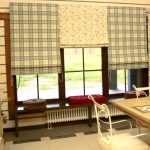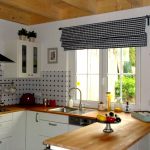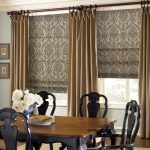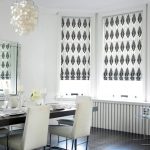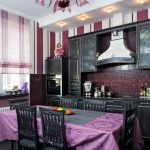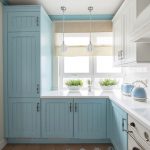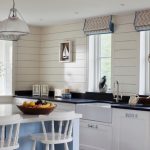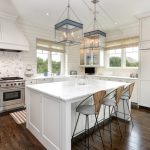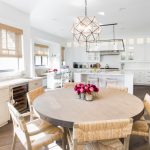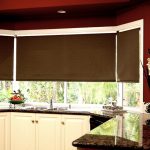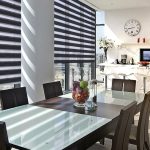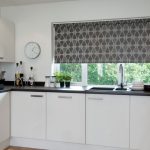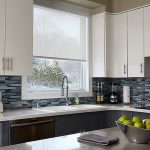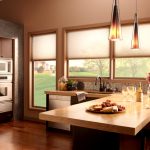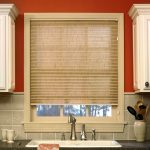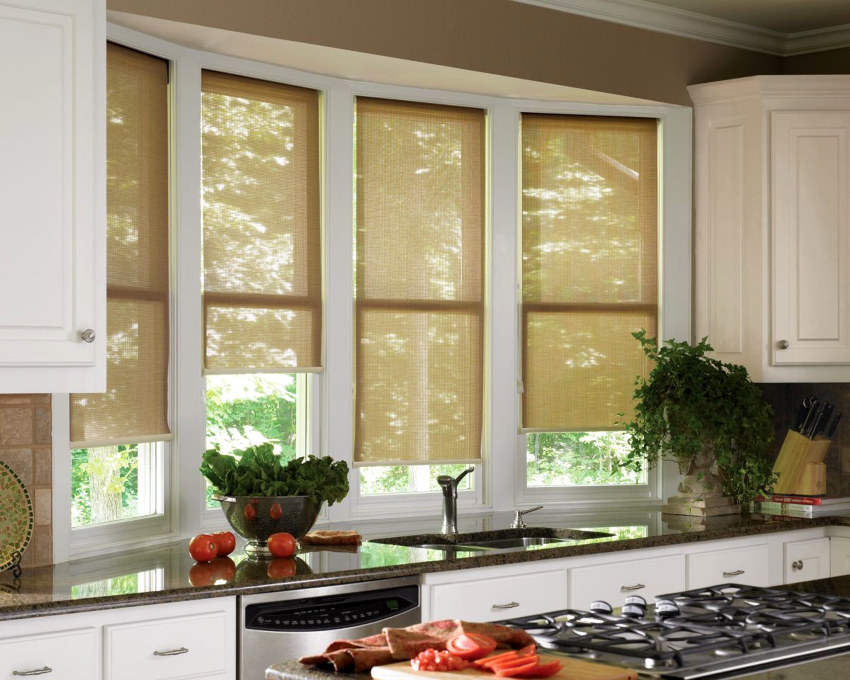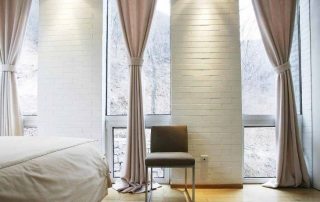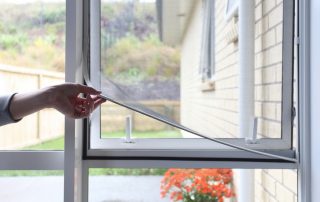No room looks complete until the windows are decorated. Roman blinds for the kitchen should be selected based on the overall style and color scheme of the room. Curtains will become not only a decorative, but also a functional element, therefore, you should competently approach the choice of length and material. The fabric from which the curtains are made must be durable and easy to clean, since the kitchen is considered a highly dirty room.
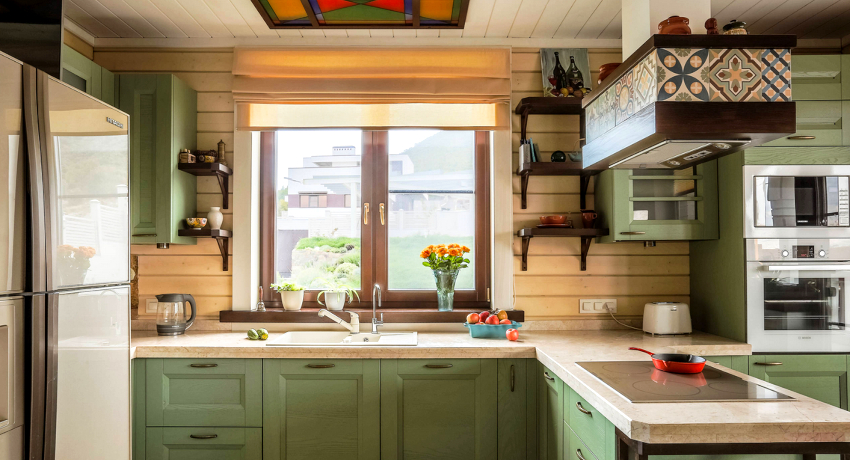
Roman curtains are not only a decorative, but also a functional element of the interior
Content [Hide]
- 1 Roman blinds in the interior: their main purpose
- 2 Roman blinds in the kitchen: advantages and disadvantages
- 3 Features of the choice of material for Roman curtains for the kitchen
- 4 How to choose the right color for products: photos of beautiful curtains
- 5 Features of fastening Roman curtains in the kitchen: photos of beautiful window openings
- 6 The main types of Roman curtains in the interior: photo of kitchens
- 7 How to make roman shades yourself: some helpful tips
- 8 The main differences between Roman and roller blinds in the kitchen: photos of different options
Roman blinds in the interior: their main purpose
People learned what Roman shades were several thousand years ago. The first version of the curtains was an ordinary piece of fabric, which was pre-moistened so that it better retained dust and dirt that entered the room from the street. Later, for convenience, the whole piece was divided into several horizontal strips.
It is interesting! The first mention of curtains is associated with the appearance of the Colosseum in the Roman Empire, where analogs of curtains were used to close the window openings of buildings adjacent to the amphitheater.
Originally, the mechanism of Roman blinds was a “pull-on” method, which was created by adjusting the threads to slats or dowels located between strips of fabric. This device made it easy to lower and raise the curtain. The main difference between the original mechanism is that the curtain rolled horizontally and was located far from the window opening. The modern twisting method makes it possible to leave the curtain on top of the window. Therefore, in fact, the meaning has not changed over time, the main changes have affected only the material and additional decorative elements.
The design of Roman curtains for the kitchen is very original. The product is a cornice, fixed on a straight canvas, which is horizontally pierced with special rods, due to which control is carried out and even folds are formed.The lower part of the curtain is framed by a special weighting agent that holds the shape of the fabric.
The adjustment is provided by a mechanism equipped with a chain or cord, using which, the curtains are easily lifted and form beautiful, symmetrical and neat folds. For the convenience of users, the curtain can be stopped at any level, which allows you to adjust the degree of illumination in the kitchen. Often in the interior you can see the combined use of Roman blinds and tulle, where the product plays the role of an element coordinating the illumination of the room, and the classic tulle is the subject of decorating the window opening.
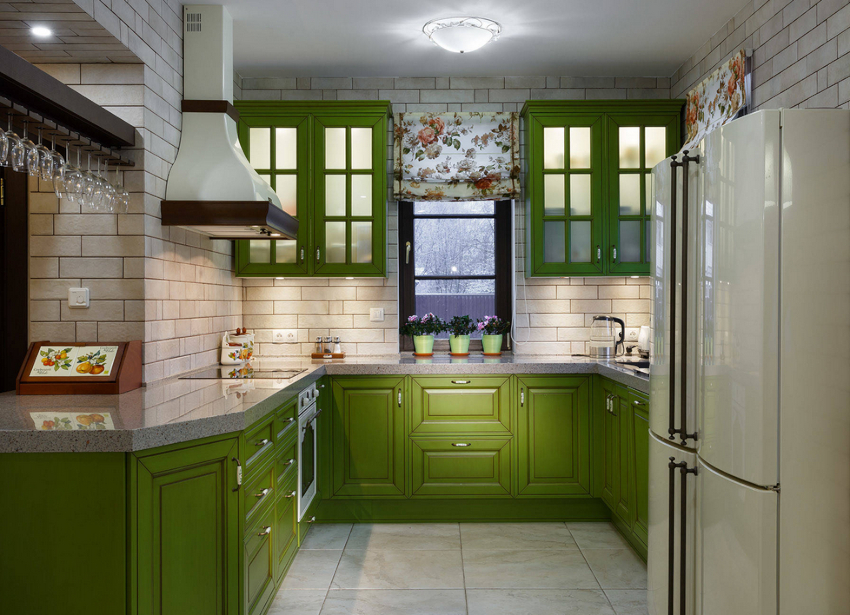
You can stop the opening of the Roman shade at any level - this allows you to adjust the degree of illumination in the kitchen
Roman curtains for the kitchen: Advantages and disadvantages
According to reviews, Roman blinds have a lot of advantages that make the products ideal for decorating the kitchen. In addition, they look nice and practical. The loose fabric of a Roman shade looks elegant and neat, and when assembled, it fills the interior with coziness, which is created due to soft and symmetrical folds. The practicality of the curtains is ensured by the optimal length of the product, which completely covers the window, while the illumination can be easily adjusted by changing the length of the curtain.
The principle of assembling curtains resembles blinds, but at the same time, even in the pictures, Roman curtains look much more comfortable, not so "office" and simple. Often the products are compared to roller blinds for the kitchen, but the principle of adjusting Roman curtains is much easier and more convenient. At the same time, an advantage is the fact that they are easy to combine with curtains and supplement with a lambrequin, which is especially important in a kitchen that is combined with a living room.
In the case of combining rooms, Roman blinds can play the role of an element zoning the space. In such a situation, only Roman blinds are installed in the kitchen, while in the living or dining area they are complemented by beautiful curtains.
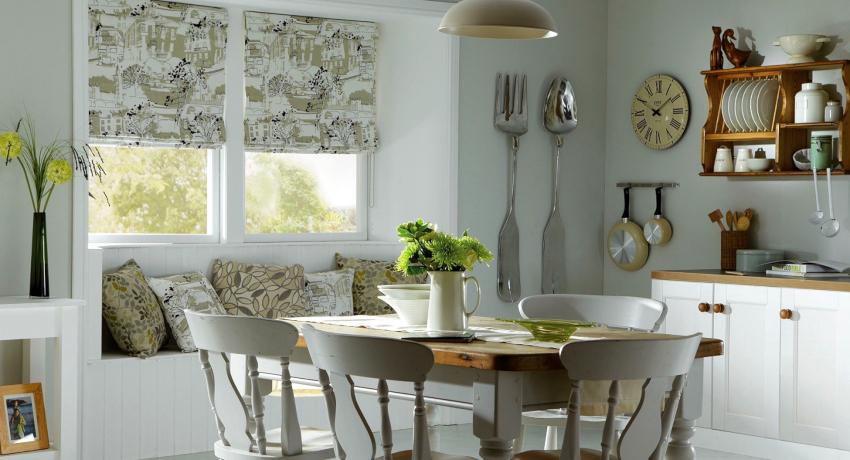
The principle of assembling curtains resembles blinds, but at the same time Roman blinds look much more comfortable
Useful advice! A good option is the installation of Roman curtains in the kitchen with a balcony, where a separate dining area is organized.
Other advantages of Roman curtains in the interior of the kitchen include the following:
- Due to their lightness, they do not overload the space, which is especially important when organizing the design of a small room.
- The product perfectly matches the size of the window and does not differ in excessively lush assembly, which allows this type of curtain to be used for rooms of any area.
- It is easy to fit Roman curtains on the window of a kitchen decorated in any stylistic direction, be it Provence, country, modern, Scandinavian or classic style.
- It is not difficult to make Roman blinds in the kitchen with your own hands: the manufacturing process does not take much time and requires a minimum amount of material.
- The product is easy to care for, because the curtains are easy to remove and wash, and do not require ironing. If hung wet, they will flatten out under the weight of the weight plate.
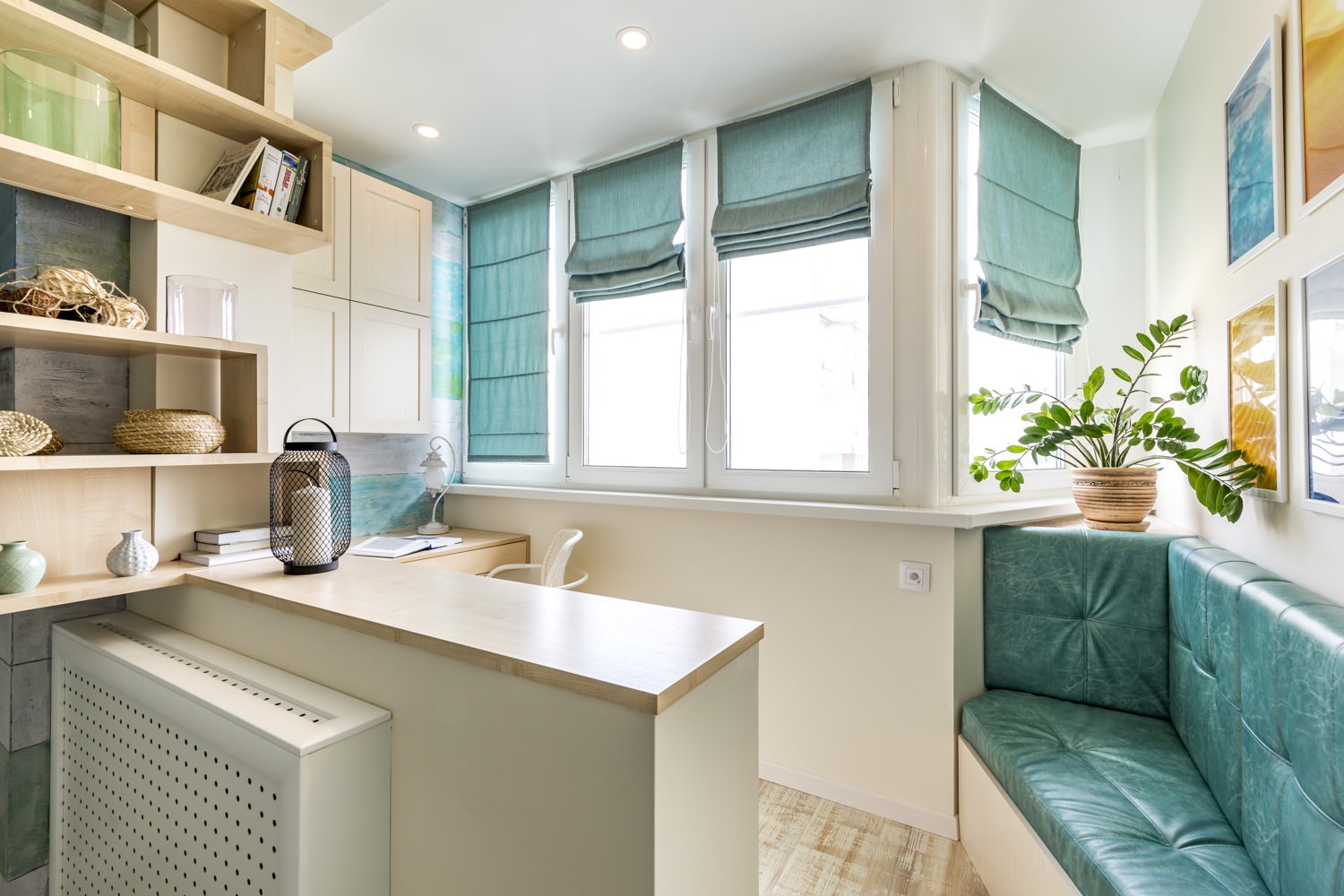
Due to its lightness, Roman shades do not overload the space, which is especially important when organizing the design of a small room
Before buying Roman curtains for a kitchen with a balcony door or just a window, it should be borne in mind that after installing them, it will not be very convenient to open the window or door wide open. If the window is narrow, then in order to get to the window handle, you will need to raise the canvas at least halfway. In the case of a complex design, it may take some time to remove all the guides and remove the lifting cords.
Features of the choice of material for Roman curtains for the kitchen
When choosing any option for curtains, be it roller, Roman or French curtains for the kitchen, the material must be selected based on the degree of daylight in the room. It follows from this that, for example, if the kitchen is filled with bright daylight, then blackout blackout curtains are recommended for high-quality darkening. These products provide almost 100% darkening of the room, but it should be noted that they are more often used to create a bedroom interior, not a kitchen.
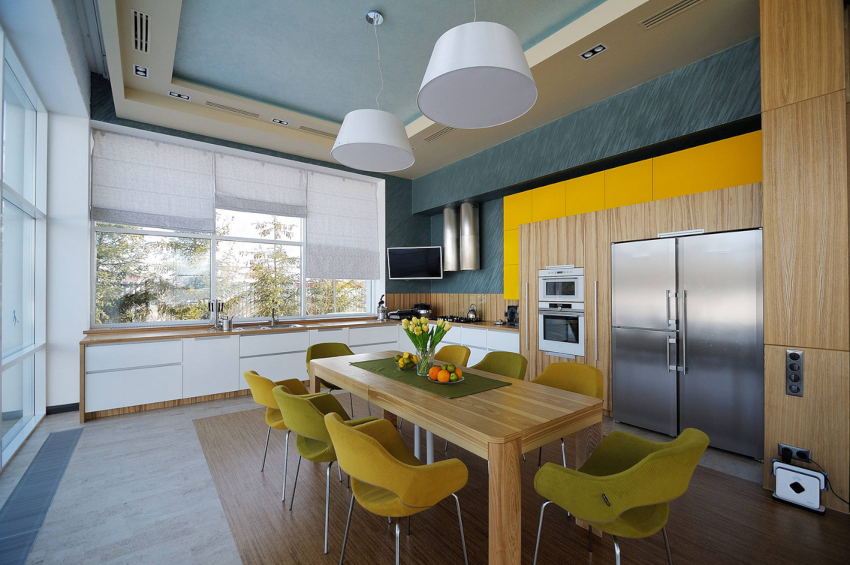
The fabric for the manufacture of kitchen curtains should be impregnated with fire-fighting compounds, especially if the product is located near the stove
Another option for the material for Roman blinds on windows is Dimout, for the manufacture of which opaque fabrics are used that let in at least 70% of natural light. It is most practical to use this option to complete the interior of a kitchen located on the brightly lit south side or on a street flooded with night lights.
A popular way to decorate a window is a day-night curtain, which involves a combination of transparent and opaque stripes, which allows you to adjust the illumination at your discretion. Such products become a good alternative to dense curtains, the main thing is that the specific design of the curtain fits into the interior. The combination of a Roman curtain with tulle looks good in the kitchen.
A room that lacks natural light requires fabric curtains with minimal sun protection. The best option is considered to be a translucent Burnout fabric with pronounced patterns. For its manufacture, a combination of polyester and natural fiber, more often cotton fabric, is used. A feature of these curtains is considered to be the fact that in daylight they are translucent, and in the dark with artificial lighting, the canvases become completely transparent.
Related article:
Kitchen curtains: an essential accessory that completes the interior
The choice of style and color depending on the interior of the kitchen. How to choose the fabric, texture and determine the desired length. Self-made.
What properties of fabrics pay attention to when buying Roman curtains for the kitchen: photo of products
Before sewing custom-made Roman shades or buying ready-made product options, you should consider the following points:
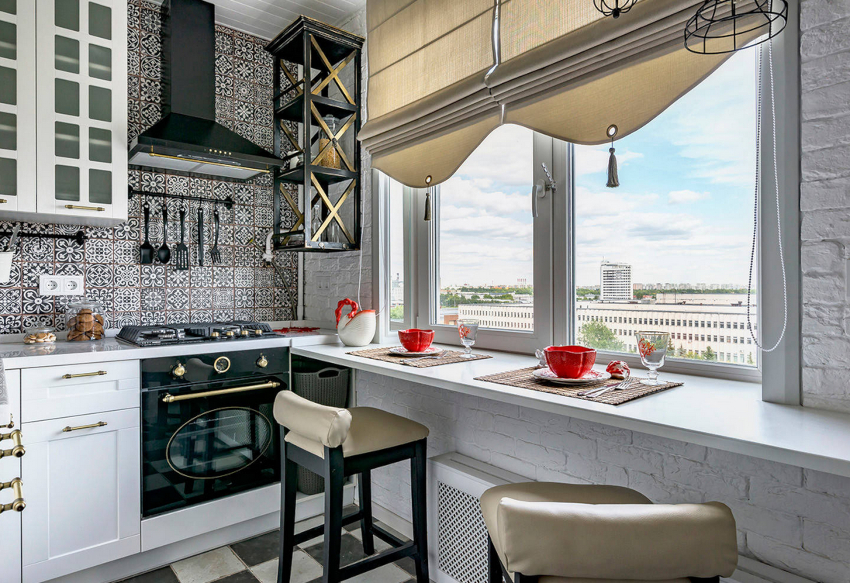
When choosing Roman curtains for the kitchen, the material must be selected based on the degree of daylight illumination of the room
- It is easier to wash curtains made of synthetic materials.
- If the kitchen is on the ground floor or there are windows of another house nearby, then you should choose denser fabrics that will create the effect of privacy and comfort.
- The fabric for making a kitchen curtain must be impregnated with fire-fighting agents, especially if the product is located near the stove.
Useful advice! If abundant condensation accumulates on the kitchen window, it is necessary that the material from which the curtains are made be treated with antifungal agents.
Practicality is considered an important parameter of both Roman and roller blinds in the interior, and it should be noted that Roman curtains, which are more convenient to operate, correspond to this requirement. The most important criterion when choosing any curtain is considered to be the correctly selected material, which not only does not absorb foreign aromas, but also is easily erased, without losing its attractive appearance, tolerates the effects of humidity and high temperatures.
The best option for creating a design of Roman curtains in the kitchen is considered to be modern textiles, which are pre-treated with antistatic and waterproof impregnations.This technology not only reliably protects the fabric from the effects of fungus and mold, but also does not allow dust or fatty particles that form during cooking to penetrate into the fibers. It is important to take into account that products whose fabric has undergone special processing cannot be washed in the usual way, only dry cleaning is suitable for them.
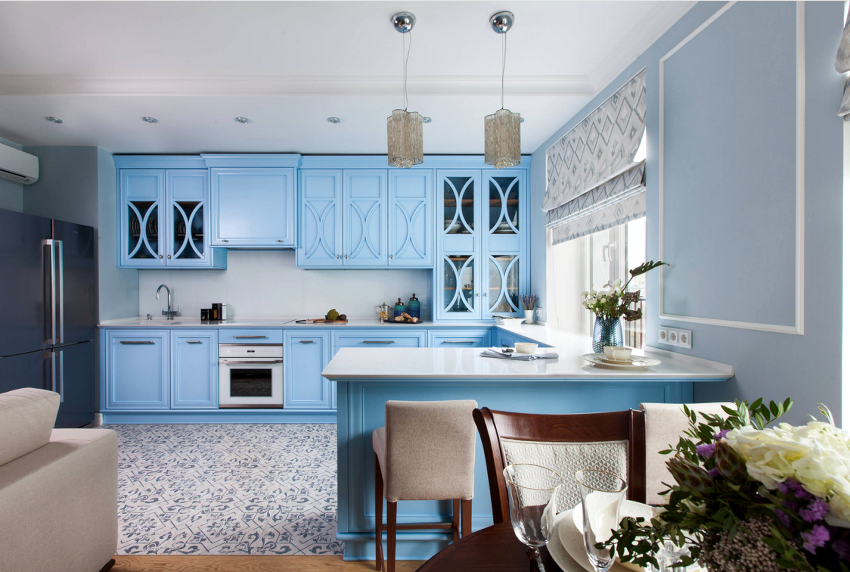
Modern textiles are considered the best option for creating a design of Roman curtains in the kitchen.
Types of fabrics that are used to make Roman blinds: photos of various options
Among the main types of fabric, the following stand out:
- synthetic;
- natural;
- combined.
Synthetic fabrics for the production of roman, roller blinds and tulle are created by a synthesis process from polymer fibers. The raw materials used are substances such as oil, coal and glass. Strength, durability and high durability of finished products can be distinguished among the positive aspects of using this type of fabric. And also curtains made of synthetic materials have a low price, are unpretentious in care and do not fade in the sun.
Negative features include the fact that products are electrified and can cause allergic reactions. The main types of synthetic fabrics:
- Polyester. The fabric does not shrink, does not wrinkle and withstands high temperatures. In the photo of Roman curtains in the interior of the kitchen, you can see beautiful folds that are easy to form due to the peculiarities of the fabric.
- Acrylic. Outwardly, the structure resembles wool. The disadvantages include the fact that pellets can form on finished products, which make them less attractive.
- Nylon. Nylon fabrics do not deteriorate even after numerous washes, they are light, smooth and resilient. A significant disadvantage is the rapid fading of color under the influence of sunlight.
It is interesting! In the production of some types of textiles, the mercerization method is used, which changes the structure of the fibers, giving the products volume and shine. The curtains retain attractive colors for a long period, do not fade or fade.
Natural fabric is made using natural fibers. The main materials include the following:
- Cotton. Hypoallergenic fabric that is durable. Finished products do not attract dust, do not electrify and are not afraid of frequent washings, but over time the curtains can turn yellow.
- Linen. The fabric, due to its structural features, is coarse and shrinks slightly when washed. The curtains are quite heavy, which makes it possible to form dense and beautiful folds.
- Wool. Non-marking fabric option, but after washing, significant shrinkage of finished curtains is possible. Due to the fact that the material is prone to absorbing odors, frequent ventilation of the products is required.
- Silk. In the photo of designs of Roman curtains for the kitchen, products from this fabric look the most luxurious and attractive. They shimmer when the light hits them and are distinguished by beautiful colors.
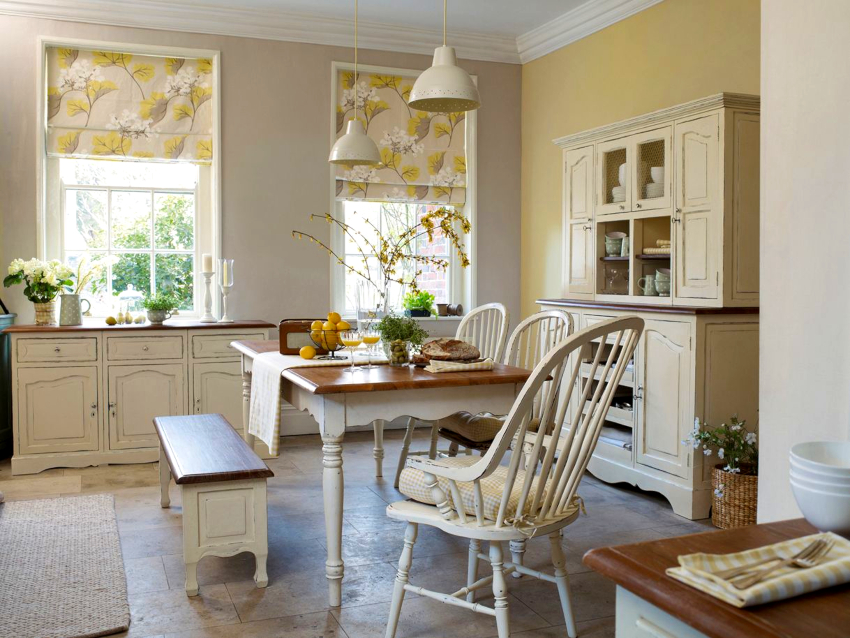
Curtains made of synthetic materials have a low price, are unpretentious in care and do not fade in the sun
For the manufacture of combined types of fabric, natural fibers are used, which are chemically processed. The most common is viscose, which is adjusted to any type of fabric. The fabric is unpretentious in use, but when it gets wet, its strength decreases, so dry cleaning is recommended for the products.
How to choose the right color for products: photos of beautiful curtains
When choosing the color and design of Roman curtains for a kitchen with a balcony door or just a window, one should proceed from the principles of the general style of room decoration.So, in a rustic or country style in the kitchen, linen or cotton products from unbleached linen, which are distinguished by a light brown color, will be appropriate. A stripe will look good in this color scheme. Features of the choice of curtains according to various interior styles:
- In a high-tech or minimalist interior, products in white or silver with strict folds look appropriate. It is better to give preference to plain canvases.
- The classic kitchen interior is decorated with heavy curtains made of silk, satin or jacquard. If the size of the room allows, then you can add tassels and fringes to the products.
- Provence prefers curtains with flowers and small stripes, more often they are light cotton fabrics. The color is predominantly light, lavender, pale purple, turquoise. In a Provence style interior, Roman curtains with tulle in the kitchen look good in the photo.
- Scandinavian or nautical style tends to be used in the interior of the kitchen in blue and white colors.
- Rooms in the English or American style are often decorated with polka dot and striped curtains.
Useful advice! Roman shades should not match the color of the walls or furniture. The main thing is that the products are combined with interior items in style and design. For rooms with plain walls, it is better to choose curtains with an ornament - and vice versa.
Roman curtains, which are distinguished by large prints, are considered a fashionable novelty, but it is better to use such canvases in a spacious room. In order to create an attractive and fresh interior, it is enough to complement the background color with a contrasting pattern consisting of two shades.
Using a striped print, you can not only decorate the interior, but also correct the size and shape of the kitchen. It is important to consider here that a vertical strip on the canvas will visually make the ceiling higher and extend the window opening in the vertical plane, but the horizontal pattern, on the contrary, will visually expand the window area.
In the photo of plastic windows in the kitchen (Roman blinds are made of linen with a bright strip of asymmetrical width), the interior looks not only modern, but also dynamic. It is especially important to use such an ornament in fusion and boho styles. If you choose the option of stripes in a milky brown color, then the kitchen will look gentle and calm.
It is important to understand that Roman blinds should be laconic and simple, because they are already considered a beautiful decoration in themselves. If you wish, you can change the appearance of the products by complementing them with modest tassels, fringes and small pompoms. The main thing is not to arrange the decor elements too densely and clumsily.
Features of fastening Roman curtains in the kitchen: photos of beautiful window openings
You can fix Roman blinds in the kitchen, on plastic windows (or wooden) in various ways, for this, different devices are used, such as:
- Velcro;
- hooks;
- rings;
- eyelets.
Roman blinds look attractive both lowered and open. If it is required not only to decorate the window opening, but also to create effective protection from the sun and prying eyes, the product must completely cover the window opening or separately each sash.
According to most reviews, roller blinds for the kitchen and Roman versions are recommended to be mounted directly in the window opening, in this case the product is fixed over the upper part of the window. To do this, the product is mounted directly on the frame, using either double-sided tape or a narrow profile cornice, which will ensure a snug fit of the fabric to the glass.
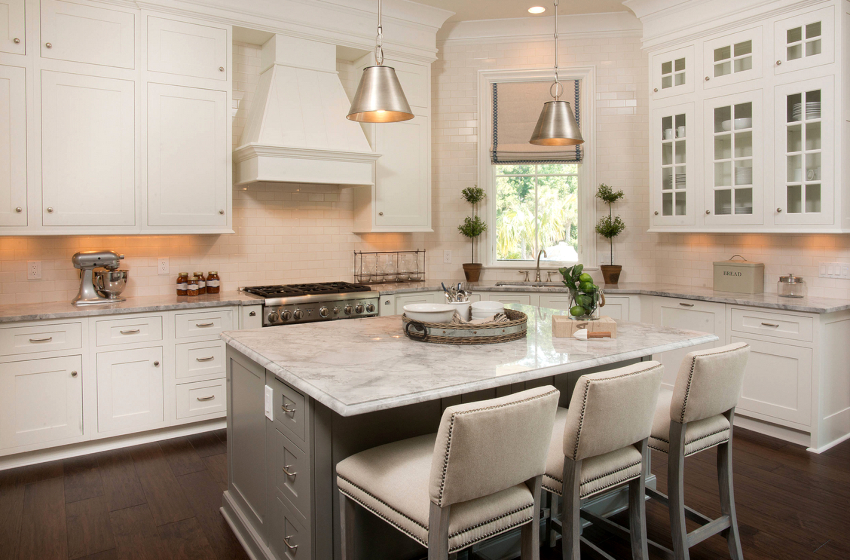
According to most reviews, Roman blinds are recommended to be mounted directly in the window opening
It is especially convenient to use this option in small kitchens, where the window sill is a continuation of the countertop or a small dining area is organized on it. Fastening in the plane of the window is convenient to use to create complex combinations, where, in addition to Roman shades, curtains, lambrequins or curtains are used.
Another option for fixing the curtains is to fix them to the wall. In this case, a profile or ordinary cornice is installed above the opening, covering the entire plane of the window. Such a curtain attachment looks good on a small window with a narrow sill.
If you want to fix the canvas on the ceiling, use a strip or a special cornice for the ceiling, with which the curtain is fixed in the upper part of the room. The method is recommended to be used for windows that differ in non-standard dimensions, or when you need to visually raise the ceiling height.
Useful advice! So that the product does not interfere with the opening of the window and reliably protect from the sun, it is necessary that the size of the canvas exceeds the parameters of the window (width and length) by at least 10 cm.
In the photo of Roman curtains in the interior of a kitchen with dormer or simply beveled windows, it can be seen that in such a situation it is better to choose narrow cornices for fastening - separately for each sash. This will protect the fabric from sagging, and the curtains will not interfere with the ventilation of the room. If the window is made in the form of an arch, then the fastening takes place using a cornice or flexible strip, the shape of which corresponds to the size of the opening. In the case when you need to install Roman blinds in the kitchen with a door to the balcony, it is better to use 2 canvases: the longer one - on the door, the short one - on the window.
The main types of Roman curtains in the interior: photo of kitchens
The most popular type of curtains for the kitchen are classic Roman models, which are a flat canvas, the width of which coincides with the width of the window, and folds are formed only after the curtains are raised. In the open position, the products look like a flat canvas. Most often, transparent organza is used for production, or, conversely, a dense fabric based on cotton or viscose. To adjust the illumination, you need to raise the curtain to a certain height.
Cascading Roman blinds differ from the classic versions in that even in the unfolded state, folds remain on the canvas. This type of product is good for creating classic interiors in modern, Provence or country style. And also cascading curtains are considered the most suitable for decorating large windows or bay windows. In bright light, they are completely lowered to shade the room, and if necessary, they are raised. If the canvas is not lifted to the end, then it will look like a lambrequin.
When it comes to creating a kitchen interior, combined with a dining room or living room, you can combine classic and cascading curtains, for the manufacture of which one type of fabric will be used. Thus, you can not only decorate the windows, but also zoning the room.
Frameless kitchen roman blinds are made without the use of stiffeners. Here, the cords, thanks to which the canvas is lifted, can be located both in the center and on both sides of the curtain. When lifted, the canvas forms neat folds that gather to the center or to the sides. If you choose the right color, then the products will complement well a modern or Japanese kitchen interior.
Roman curtains are distinguished by various types of lifting mechanisms, which are divided into the following types:
- cord and rings attached to the curtain;
- rotor-chain mechanism, acting on the principle of roller blinds or blinds;
- electric drive, more often used for curtains that close large panoramic windows.
How to make roman shades yourself: some helpful tips
Before making a Roman blind, you need to first calculate the amount of fabric that will be needed to make it. The amount of material mainly depends on the place and method of attachment:
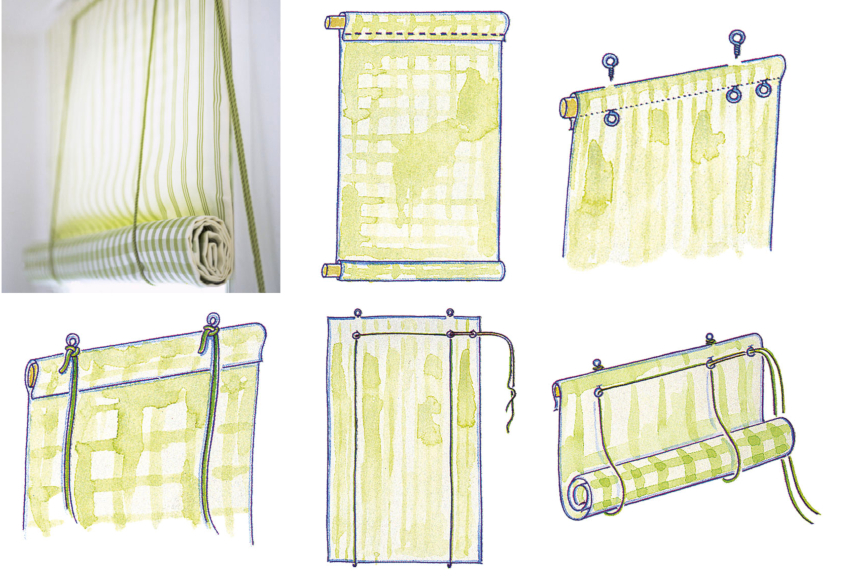
Before sewing, you need to calculate the required number of carriages - the main mechanisms with which the web is lowered and raised
- If the fixation is carried out in a window opening, then the distance between the slopes is measured.
- When attaching the curtain to the wall, it is required to measure the entire width of the window opening and add small allowances on both sides.
Useful advice! It is better to take several measurements, because the window often has narrowing or widening, which is important to consider when sewing.
The length of the Roman blind should reach the level of the window sill, especially if a deep window with a wide window sill is decorated. If you take out the Roman curtain behind the line of the window sill, most likely, there will be gaps on the sides of the curtain, which will have to be closed with tulle or curtains. The cornice, on which the canvas is fixed, is often fixed to the wall above the window or on the ceiling; the final length of the product also depends on the chosen option.
The width of the curtains that are attached directly to the wall should be greater than the size of the window opening. To do this, it is advised to leave a margin of 3-4 cm on each side, which will prevent the formation of cracks and gaps. It is also important to leave 5% of the fabric in reserve when planning the length and width in case the fabric shrinks after washing. It is best to wash the linen before cutting it.
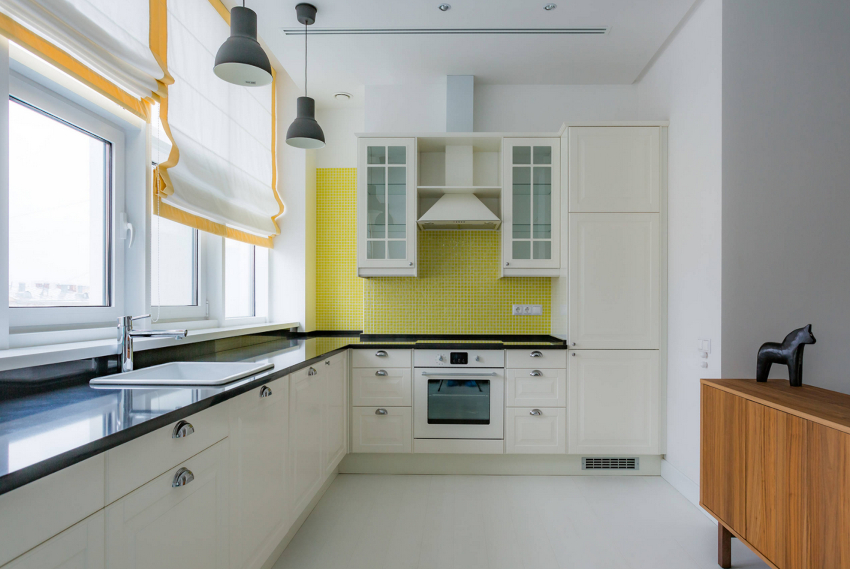
Before making a Roman blind, you need to first calculate the amount of fabric based on the type of product
Most often, the fabric is sold in rolls, the width of which is 140 cm. This size is enough to make a curtain for a window up to 120 cm wide. If the window opening is larger, you can try turning the fabric over if the print allows it. A good way to "grow" the width is to make edging or other decor.
Before sewing, it is important to calculate the required number of carriages - the main mechanisms by which the canvas is lowered and raised, it is from them that the ropes or chains come out. In general, it is recommended to install the carriages at least every 50 cm, and it is imperative that one is fixed at each edge of the curtain. Thus, 3 carriages will need to be used on a 1 m wide canvas. If a heavy fabric is selected for sewing, it is better to set one more carriage.
The curtains also include the so-called twigs, the number of which depends on the length of the canvas. The minimum distance between the rods should not be more than 35 cm. When ordering rods and a plumb line, to ensure the tension of the fabric, it is necessary that their width is 1 cm narrower than the width of the canvas, so that they do not protrude beyond the curtain.
The main differences between Roman and roller blinds in the kitchen: photos of different options
Despite the fact that in the photo the roller blinds for the kitchen look very different from the Roman ones, all the same, the products are often confused, because they have a similar fastening method and general scope. According to reviews, roller blinds, like Roman ones, are characterized by a long service life. Let's consider the main differences between these types of curtains.
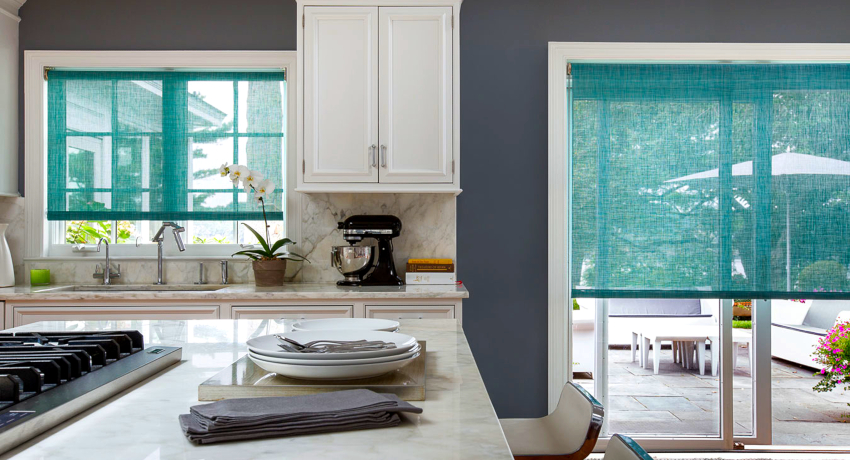
Roller blinds and roman blinds for the kitchen are often confused because they have a similar mounting method and general scope.
Appearance. In the unfolded state, both options completely cover the window opening, but when raised, Roman shades form folds, while in the photo of the designs of roller blinds for the kitchen, you can see that when closed, they completely hide in the cornice.
Lifting mechanism. Both Roman and roller blinds are controlled by a chain or an automatic drive.However, roller blinds are gradually wound on the shaft, which is hidden in the cornice, and Roman blinds are raised due to special inserts in the canvas, which ensure uniform drapery.
Material. For the production of Roman blinds, a standard type of curtain textiles is used, which is treated with compounds that prevent burnout and the appearance of fungus, and the roller blinds are additionally impregnated with dust-repellent agents, which simplifies the care of the product.
Cost. Roller blinds are in a lower price point and are considered budget window décor options. Roman curtains, due to a more complex design and type of control, are 10-20% more expensive - it all depends on the type of fabric chosen.
Roman blinds in the kitchen will be a great addition to any interior. It is especially recommended to install the products in rooms where ordinary curtains will not look harmonious, for example, in a kitchen with a balcony or with a non-standard window. The unusual design of the curtains will not only decorate the room, but also protect from excess sun, create an atmosphere of comfort.
